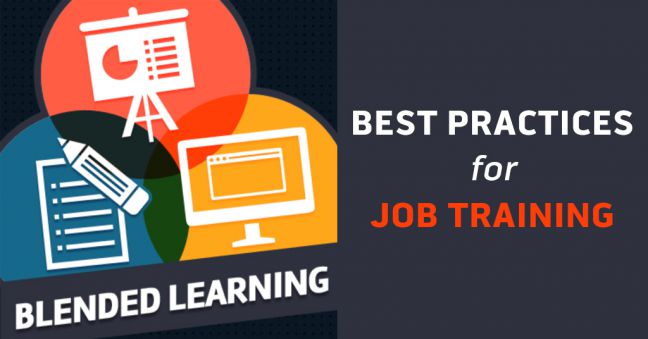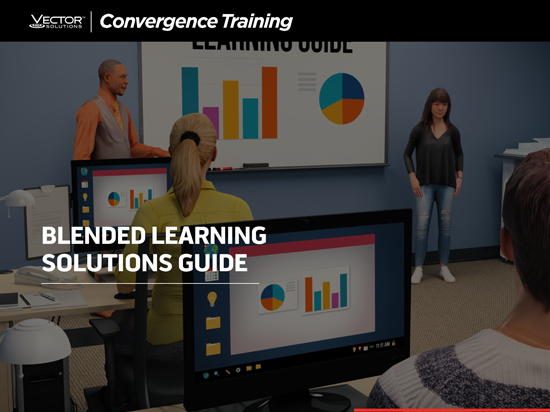
“Blended learning” is one of the hot buzz phrases in learning circles these days. The concept means nothing more than delivering training using multiple instructional methods (instructor-led training, elearning, written materials, field-based training, etc.). Most commonly, it’s used specifically to refer to mixing both instructor-led and online training, although we feel that’s an unnecessarily limited way to look at it.
The idea’s been around a long time, but it’s gained momentum over the past decade as online learning has become more accessible and easier to pair with more traditional instructor-led courses, OJT, and other forms of training.
There are many learning management systems (LMSs) on the market designed specifically for workforce training and most of them offer blended learning support – delivering online training while also allowing you to assign, track, and report on other forms of training, including face-to-face/instructor-led training. And blended learning solutions are becoming even easier to track and report on with the advent of the Experience API (xAPI).
But what are we really talking about when we’re talking about blended learning for job training, and how is it supposed to benefit you? Let’s take a closer look.
- Learning Management Systems
- Online Workforce Training Courses
- Incident Management Software
- Mobile Training Apps
What Is Blended Learning?
Traditionally, blended learning means training that includes an online component and an instructor-led component.
More recently, the phrase has sort of morphed so that some people use it to mean mixing training of different types. We’ll talk about blended learning in that broader sense, although of course what we’ll say applies to the stricter, more traditional online/instructor-led blending as well.
Where’s the Evidence That Blended Learning Improves Training Effectiveness?
This report from the U.S. Department of Education and this second report by Dr. Will Thalheimer both note increased learning results from using blended learning solutions.
For more on this, see our interview with Dr. Will Thalheimer in which he explains the benefits of blended learning solutions.
Why Is Blended Learning So Good?
By following blended learning best practices, there are number of ways you can make your job training more effective. How? We’re going to list some ways below.
(Note: Once you’ve finished reading this article about blended learning, you may also find this second blended learning article, which focuses on creating by blend by considering the kind of knowledge or skill you’re trying to teach and the need for feedback and/or practice during the training, interesting too.)
Blended Learning Can Help Employees Satisfy Learning Objectives
Sometimes, training in a particular format can help your employees acquire the required knowledge, skill, or attitude more effectively. Maybe an online learning module or a lecture would be perfect for explaining the features of a new product to the sales team, while hands-on, OJT training is best to teach a worker a new skill in a manufacturing setting.
Blend your learning so you can help you employees learn what they need to know.
Blended Learning Solutions Can Help Match Different Learning Preferences
Research is inconclusive about what has traditionally been called “learning styles,” and many in learning and development no longer believe in them. But it stands to reason that some people may prefer to learn in different ways. For example, some may prefer learning with the aid an instructor in a classroom setting, while others may prefer learning an online module on their own. If you can create training that appeals to these different learning preferences, why not? This point also applies to all that talk about younger, Gen-Y workers who may prefer learning online while older workers prefer instructor-led training, by the way.
Blended Learning Solutions Can Help You Match Different Training Schedules
Instructor-led training or field-based training typically requires having an instructor and one or more trainee meet at a specific date, time, and location. That’s fine in some cases, but in other cases it causes difficulty or additional expense because the training doesn’t fit well into the employee’s schedule.
Using a blended learning solution allows you to craft training solutions with this in mind.
Blended Learning Solutions Can Help You Respond to Different Assessment Needs
Different types of training can involve different types of assessment. Is it OK if the employee just checks off that they’ve read and understood something? Do you need them to pass a test? Or maybe you need them to demonstrate skills properly to a supervisor?
Blended solutions let you do all of this (and more).
Blended Learning Solutions Can Help You Meet Recording, Reporting, and Compliance Requirements
Keeping records of completed training is irrelevant sometimes, desirable or important other times, and absolutely essential still other times (think: mandatory OSHA-required safety compliance training).
Select a form of training that best fits your recording needs.
Blended Learning Solutions Help You Align to “Real Life” Realities
Like it or not, real-life factors unrelated to training effectiveness will sometimes influence your training decisions. You may have to consider contradictions between training needs and production schedules, travel logistics, costs, the need to pay overtime to complete training, workers at your site and workers at remote facilities, and other similar factors when selecting the training for a given purpose.
Common Blended Learning Methods
You may be familiar with the strengths of these common training methods already, but let’s take a quick look (we cover this in more detail in the included guide at the bottom of this article).
Some Advantages of eLearning
eLearning courses help you deliver a standardized and consistent message and allow you to use sophisticated visuals to increase comprehension and retention. They help address distance-learning needs, such as making it easier to deliver training to workers at remote work sites, on different shifts, or to workers who were absent during regular training. They also make assessment of simple knowledge-based items automatic and ease record-keeping duties when paired with a learning management system (LMS).
Some Advantages of Instructor-Led Training
Instructor-led training increases the opportunity for instructor/learner feedback, can help with assessment of more complicated behaviors, and can be performed quickly on a spontaneous basis.
More than ELearning and Instructor-Led
Remember your other options, including:
- OJT, such as shadowing/following, mentoring, and skill demonstrations/evaluations
- Written materials in Word, PowerPoint, or PDF formats
- Webinars
- Videos
- Audio recordings
- IM chat
- Online Wikis and bulletin boards
- Various social media/social learning and collaboration formats
- Informal learning
Formal Assigned Learning, Informal Learning, Social Learning, and More
Another way to think of blended learning solutions is by considering the so-called 70/20/10 model.
This model of workforce learning suggests that workers develop much of their knowledge and skills directly on the job (the “70”); a good deal of it socially (the “20”); and the rest through formal training assignments and programs (the lowly “10”). Don’t get too hung upon the actual numbers, but recognize that people DO learn outside the formal assigned training program and see how you can help facilitate that blend.
For more information, read our entire article on 70/20/10.
Game-Based Learning, Gamification, Scenario-Based Learning, and More
In addition to “normal” job training, you can also add elements of gamification and scenario-based learning into your learning blend.
Work Support and Job Aids
Sometimes you can do without training and just create work support materials or job aids that employees can refer to when they need the information on the job. That’s what a job aid does (and this factors into the 70/20/10 model we were just discussing).
Primary/Initial Training and Refresher Training
You can also think of blended learning solutions as involving a mix of primary, or initial training, and refresher training.
To learn more about this, read our articles on Training and the Forgetting Curve, Spaced Practice for Combatting the Forgetting Curve, and Evidence-Based Training and Spaced Practice.
Learning Management Systems (LMSs) to Help Administer Blended Learning Solutions
A learning management system, or LMS, can help you administer a blended learning solution.
That includes:
- Assigning
- Creating
- Delivering
- Crediting/tracking
- Reporting
- Facilitating informal learning solutions
- More
Check this short video overview to learn more.
How Do You Use Blended Learning?
What about you? What are your tips for using blended learning? We’d love to hear your thoughts. Leave them below in the comments section.
And don’t forget to download the free Guide to Blended Learning Strategies, below.

Guide to Blended Learning Strategies
Learn the importance of using differing training delivery methods and get some tips for selecting the right training method for each training need.
Thank you for this informative post. We are using blended learning in our Environmental Biology class. We use videos, field observations, group works in making posters and mind maps, debates, case studies, and the usual documents in pdf and word.
Glad you found that helpful, Grace. Your BIO class sounds like a blast–wish I could attend. Enjoy!